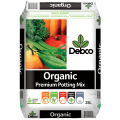Creating a beautiful outdoor space is one of the privileges of having your own home, where you can literally put down some roots.
If you’ve inherited a well-established garden, most of the hard work is done for you although you may want to make some modifications.
But if you’re starting from scratch, here’s our easy step-by-step guide to help you make a new garden bed and establish your own piece of paradise.
Gardening tools and products needed to build garden beds
To build a new garden bed, you’ll need:
- Flexible garden hose
- Paint can (to use as a spot marker)
- Spade
- Soil pH test kit
- Lime, compost, manure or sulphur depending on the pH of your soil
- A soil composition test
- Soil improver, compost and manure
Step-by-step guide: how to make garden beds
Here are our five simple steps for making a garden bed:
- Mark out the beds
- Remove existing lawn and plants
- Work the soil
- Do a soil test
- Improve your soil
1. Mark out the garden beds
Using your plan (or napkin sketch) mark out the new garden beds.
- Use a flexible garden hose to outline the beds. Tweak until you are happy with the shape and depth of them.
- Use a spot marker (paint can) to trace around the hose, marking the outer limit of the beds clearly.
2. Get rid of grass and plants in the garden bed
There are several ways to clear away existing lawns and weeds; the decision comes down to doing it by hand or using a herbicide.
- Removing by hand involves digging up the garden beds and pulling all the weeds and sprigs of grass from the soil. It is important to get as much of the existing plant material out of the soil as possible, otherwise plants regrow.
- Using a herbicide is simple. Spray the area with an appropriate herbicide product (non-residual and non-selective) and wait for the plants to die. They can then be dug back into the soil where they will decompose.
It's safe to plant into glyphosate treated areas three or more weeks after application. - Other methods include laying black plastic over the new garden beds and letting the sun cook the plants and heat treat the soil to kill roots and seeds.
3. Work the garden bed soil
Using a spade, dig the soil over to a depth of at least a spade and a half. This helps open up the soil to improve air and water penetration. Don’t be too fussy at this stage, just break it up roughly as the next step will involve turning the soil again.
Watch our video on how to create a healthy soil the easy way.
4. Do a soil test
There are two soil tests you should do so that you know what you’re dealing with.
Soil pH determines which nutrients are available to plants, so it’s important to know where you're starting, and if your soil needs a pH adjustment.
- pH test kits are available at nurseries and garden centres. You simply take a sample of your soil and dust with a powder that will change colour. You compare the colour to a card included in the pack, and that’s the pH of your soil.
- To increase or raise your pH, add lime.
- To decrease or lower pH, apply compost, manure or sulphur.
- The ideal pH for most garden plants is between 5.5 and 6.5.
Soil composition tests show what your soil is made of. After this test you will know if your soil is sandy or clay based, and the best way to improve it.
The ideal soil should be around:
- 40% Sand
- 40% Silt
- 20% Clay
5. Improve the soil in your garden bed
All soils can be improved with the addition of organic matter.
- Spread compost and soil improver and well weathered manure over your new garden beds and use a garden fork to turn into the soil. This helps to not only break up the existing soil, but incorporate the organic matter throughout the soil profile.
- Be generous - this is the easiest time to really improve your soil, while the garden beds are empty.
- If your soil test showed that your soil has a high clay component, add gypsum now too. This will help break up the soil and keep it open.
Check out our guide on how to create healthy soil.
What to put in a garden bed
Now you’re ready to plant. Discover more about planting and caring for new plants, as well as the top 10 tips to create a beautiful garden.










